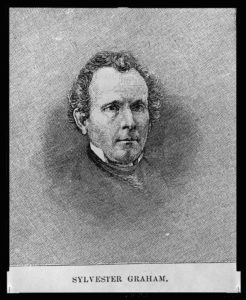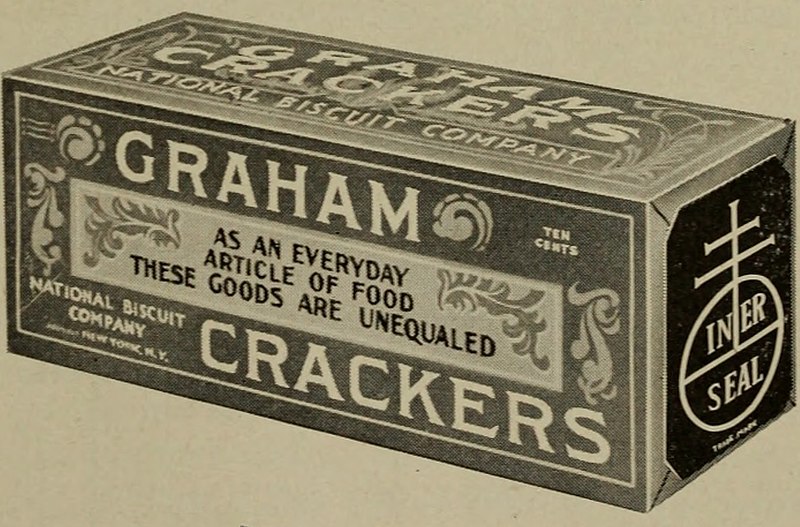By Emily Clark
With so many Americans consumed by diets promoting “clean eating” and “low-carb,” one would think that trends such as these are unique to recent times. Health food fads, however, can be traced back hundreds of years, even to 18th-century Connecticut and a local man often called the “father of vegetarianism.” An outspoken Presbyterian minister, Sylvester Graham is known as much for his sermons on morality as his advocacy of a healthy lifestyle, one which included a high-fiber, low-fat diet and the creation of a snack found today in many kitchen cabinets: the graham cracker.
Graham Crackers: Part of a Healthy Regime
Born in West Suffield, Connecticut, in 1794, this future evangelical preacher briefly attended Amherst College before becoming ordained in 1826. After lecturing for a short time around New England, Graham suffered a long illness that led to the health regime for which he is known today, one full of progressive ideas. This included consuming whole grains, fresh fruits and vegetables, and abstaining from stimulants such as coffee and tea. A strong believer in the temperance movement, Graham also condemned the use of alcohol and tobacco. Though these opinions were not so unusual, even in the 1820s, it was his support for vegetarianism and criticism of refined flour that drew the most attention.
After experimenting with unsifted, coarsely ground wheat, Graham created graham flour, followed by graham bread and eventually the “Graham cracker” in 1829–goods that he baked himself. Noticeably absent from these high-fiber foods were the chemical additives common in white bread, which was typically produced in large factories beginning at the time of the Industrial Revolution. In his Treatise on Bread and Bread-Making, Graham wrote, “Thousands in civic life will for years, and perhaps as long as they live, eat the most miserable trash that can be imagined in the form of bread and never seem to think that they can possibly have anything better, not even that it is an evil to eat such vile stuff as they do.” He believed his graham products capable of changing it all.
Supporters and Critics

Sylvester Graham, New York : Harper & Brothers, 1880 – Library of Congress Prints and Photographs Division
Graham’s radical principles drew a strong following of devoted supporters dubbed “Grahamites,” especially after the cholera epidemic of the 1830s when people’s health concerns intensified. During this time he began to lecture again, albeit more widely, garnering national attention with his renewed emphasis on temperance, sexual restraint, and meatless consumption. As a regular speaker with the Philadelphia Temperance Society, Graham lectured on the connection between diet, disease, and hygiene, blaming weakened immune systems on poor eating habits. He attracted hundreds who were inspired by these health reforms, which even spawned Graham restaurants and Graham boardinghouses in New York and Boston. Some followers also joined a group of intellectuals and transcendentalists in a short-lived stint in communal living at Brook Farm in Massachusetts. In the 1840s, Graham himself created a group committed to the advancement of vegetarianism, modeled after the newly established British Vegetarian Society.
This radical reformist was not without his critics, though. In his promotion of whole grains, homemade bread, and meatless meals, Graham criticized butchers for their cruelty to animals and commercial bakers for their use of refined flour and chemical additives. This created such fury among grocers in Boston that they rioted against him at a hotel in 1837. Others, however, took a lighter perspective in their criticism of Graham. Ralph Waldo Emerson labeled him “the poet of bran and pumpkins” while a writer for a Northampton, Massachusetts newspaper called him “Dr. Bran, the philosopher of sawdust pudding.”
Graham’s Enduring Legacy
Though Graham claimed his whole grain and vegetarian diet could help people live to one hundred, he himself died at age fifty-seven at his home in Northampton, a building which now houses Sylvester’s Restaurant.
Despite both praise and disapproval of his progressive ideas, few can deny the impact Sylvester Graham had, and continues to have, on Americans’ dietary and lifestyle behaviors. Physical exercise, proper hygiene and sleeping habits, regular meal times, and the humane treatment of animals were important considerations in one’s health regime in the 19th century–and continue to be so in the 21st. Though not everyone has become a vegetarian as Graham may have wished and Americans still consume alcohol and enjoy a sandwich on white bread, they also find it hard to resist those sweet and crunchy crackers which continue to bear his name.
Emily Clark is a freelance writer and an English and Journalism teacher at Amity Regional High School in Woodbridge.









